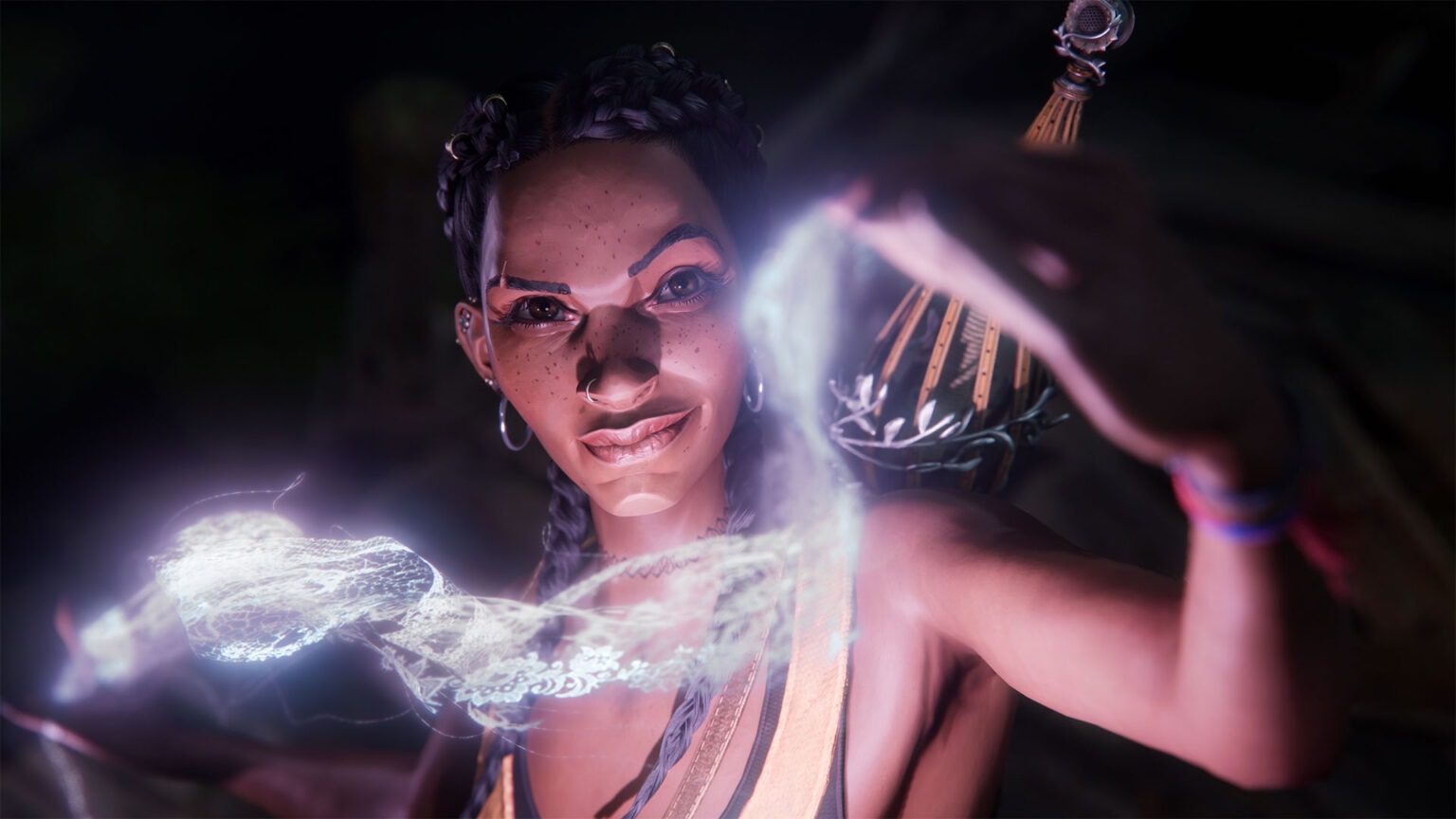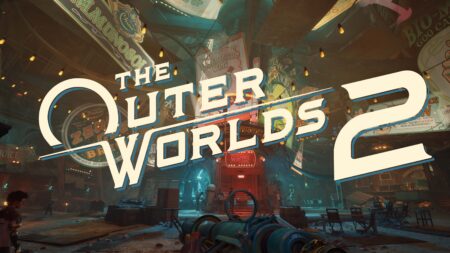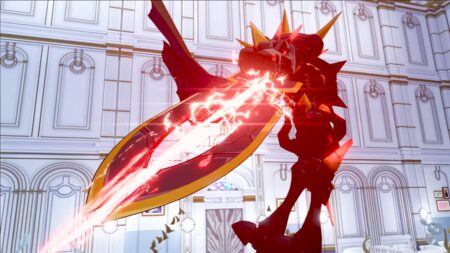South of Midnight is a modern fairy tale steeped in myth, memory, and Southern soul. It offers a tender, evocative glimpse into Black Southern culture, woven with love, pain, and ghosts. At its heart is a heroine who is unforgettable; Carrying a story full of truths that linger well past the final chord. Please put this one first.
Like a folk song coming to life, South of Midnight is full of flavor, soul, and spirits too proud to rest. The game’s rhythm, its slow-burning narrative, its winding, myth-soaked landscapes, echoes the plucking strings of Mariee Sioux. The way the story unravels feels much like her song ‘Ghosts in My Heart’: delicate, haunting, and raw, each moment steeped in history and longing. Even without her voice, its ghost hummed through the game, slowly matching its ebb and flow like a forgotten hymn remembered by instinct.

“You told me graves are shaped like hives of sunbeams”
Before you even meet our characters, South of Midnight’s world pulls you in. Set in Chickasaw Country, a fictional vision of the American South, it is brimming with charm, history, and quiet mysteries. Prospero, the town at the game’s heart, is slowly fading away, burdened by disappearances, slow decay, and the steady creep of nature—like so many old towns left behind. Those who leave are chasing dreams of brighter days, while those who remain can only linger among memories like ghosts caught in sunbeams.
Prospero feels authentic, weathered, and alive, shaped by an art direction that’s both mystical and whimsical. Its clay-like textures and purposefully subdued colours highlight surreal imagery throughout the landscape. Moments of vibrant wonder stand out vividly against the dreary backdrop, a coffin lodged mysteriously on a hill, a cow inexplicably perched atop a barn, a sewing machine hidden deep within a cave. Each strange tableau feels deliberate, captivating, and poignant, designed to let these symbolic details shine.
Exploring Prospero is a richly rewarding experience. Every nook invites curiosity, not just for hidden upgrades but for the wealth of stories waiting to be discovered. Dare I say: The environmental storytelling holds as much emotional weight as the main narrative itself.
From a graduation sign for the class of ’84 vandalized in faded blue graffiti, a lingering whisper of happier times lost to change, to quirky sights like that cow stranded atop a flooded barn roof, taxidermied pets solemnly watching from abandoned living rooms, or a room full of pans, every detail adds layers to an immersive experience. Even the quiet notes left behind by vanished residents echo softly, giving Prospero a tangible, lived-in feel.

“Little kids’ mamma’s have your name in their mouths; Even my mama’s got your name in her mouth”
The characters in South of Midnight feel like they’ve lived through generations of stories, traumas, and whispered truths. Everyone in Chickasaw seems known before they’re introduced, their names carried on porch gossip, church benches, and bottle trees. And at the center of it all is Hazel.
Hazel isn’t your typical video game protagonist. She’s a track star who can’t swim, a fighter who carries more than just magical strands—she carries generational weight. Her story begins in the storm—both literal and emotional—just as she’s preparing to leave Prospero for college, with her the weight of fractured relationships and unanswered questions.
Her mother, a social worker, is the emotional backbone of the game’s conflict. Torn between helping others and connecting with her daughter, she becomes both anchor and ghost. Their relationship simmers with love, resentment, and unspoken truths. Hazel’s journey isn’t just about chasing monsters—it’s about reconciling with her past, her family, and the echoes left behind. Her father’s side remains estranged, adding another layer of tension, another space for her identity to unfold.
The people Hazel meets along the way are just as layered. There’s Beaux, a man of dogs and fishing lines, who says more with what he doesn’t say. Then there’s Hazel’s estranged grandmother Bunny—stern, mysterious, and hard to read. Her presence is heavy, her words wrapped in riddles, and trust is never freely given. Hazel also encounters magical creatures that offer both wisdom and ferocity. These beings are beautifully written, ethereal, and surprising. To say more would spoil the magic.
The writing never paints in black and white. Some of the most seemingly kind characters hold thorns beneath their smiles. Others, cold at first, slowly reveal softness and sorrow. The game makes it clear: trust what folks do, not how they seem.
Hazel’s story is told with nuance and care. Her voice acting, her expressions, even her quiet moments carry emotional weight. You feel elation when she triumphs and ache when she falters. With just a slight tonal shift, she could easily be the second Southern Disney princess; Fierce, tender, and unmistakably human.

“And the ghosts in this town, they can’t walk the walk / But every kid in this town can talk the talk”
Hazel is a Weaver—by both title and truth. It’s not just what she does, but who she is. In a land riddled with broken spirits and buried histories, her role is to mend. She doesn’t just fight the ghosts of the South—she listens to them, threads through them, and, when she can, brings them peace—by bottling up the pain, finding the truth, and mending the hurt. Her magic, grounded in strands and echoes, is both weapon and balm.
This weaving isn’t limited to combat. It’s stitched into how she moves. Hazel runs, leaps, glides, and wall-runs like she’s threading her way through the land’s hidden seams. A step in one direction takes her through a field of wildflowers; a step the other way pulls her into flooded ruins or forgotten corners.
Her traversal is empowering, but always grounded. Every ledge cleared, every wall climbed, feels like a moment of resilience. It’s not about domination—it’s about navigating a world that’s trying to hold her in place.
She wields enchanted hooks tethered to strand magic, giving her a standard combo string to work with, but combat isn’t about stylish execution—it’s about holding your ground. Her enemies are Haints—restless spirits twisted by pain, memory, or something far darker. They come in many forms, some human-like, others monstrous or barely shaped. Among her tools, Strand push interrupts incoming attacks and creates much-needed space, while strand pull yanks smaller enemies close or pulls Hazel herself toward larger threats.
Combat builds tension not through spectacle but through pressure. It’s about managing cooldowns, prioritising threats, dodging smart, and attacking with intent. Difficulty settings are abundant, with a custom option for those who want to fine-tune the pressure. Death isn’t punishing either. When Hazel falls, she’s given the choice to return either just before or outside of combat. And when she comes back, it’s with style—suspended in the air, spinning with her strands like she’s performing a surreal Cirque du Soleil rope act. One of the coolest return-from-death screens in any game ever.
There are no overwhelming combo trees or complex parry systems—just steady escalation. A test of patience and presence, stitched into every encounter. Haints can’t walk the walk, they linger; Hazel moves forward.

“Hallelujahs, Hiding and Seeks”
But South of Midnight isn’t a game about combat; Not really. It’s a game about presence.
Yes, there are battles—some tense, some breathtaking—and boss encounters that demand your full attention. But the soul of the game lives in the quiet corners. The in-betweens. The flashbacks. The half-empty homes where memories hum louder than ghosts. It’s in the stillness, where nothing seems to happen—and yet everything unfolds.
Exploration is a full-bodied experience. Some maps won’t open until you’ve cleared the haints from them. Others give you time to breathe, to notice, to uncover. Even the parkour flows like a conversation with the land, each leap and glide answering a whisper you didn’t know was calling.
Throughout your journey, you’ll stumble across the kind of small things that quietly change everything: A child’s dress hanging by a clothesline. A note left in apology. These discoveries carry as much weight as any boss fight.
South of Midnight invites you to look, not just play. The heart is in the seeking. The hallelujahs. The stillness.

“The ghosts in my heart, they can’t get no rest”
I was just looking for some upgrade points at some random part in the game when I found it—an innocent grocery list sitting quietly in the world, half-forgotten. I laughed at first. It listed beer, which felt oddly personal, like a wink. Then I read a little further. One line broke me:
“Chocolates for Patricia to say sorry.”
It was so small, so human. An apology tucked into the mundane. A story in a single line. And to top it off, beer showed up twice.
South of Midnight transcends being just a game. It doesn’t simply entertain or impress—it gives. It gives space to grieve, to reflect, to heal. Beneath its art and action lies a deep, aching tenderness—a message about the weight of pain, and the courage it takes to carry it, especially when it’s not yours to begin with.
There are echoes of history here—of slavery, of generational trauma, of communities that had to endure more than most and still found ways to survive. One line from the game lingers: “Hurt people, hurt people.” It’s the kind of truth that stays with you.
Mariee’s song echoed what South of Midnight had been whispering: that the ghosts in our hearts can rest, if we have the courage to face them. To name them. To forgive, or at least try. And maybe, just maybe, South of Midnight wasn’t just telling a story… it was pulling the strings all along.
This review is based on an Xbox Series X|S review code provided by the publisher. Reviewed on the Xbox Series S.
South of Midnight (Xbox Series S)
Mariee’s song echoed what South of Midnight had been whispering: that the ghosts in our hearts can rest, if we have the courage to face them. To name them. To forgive, or at least try. And maybe, just maybe, South of Midnight wasn’t just telling a story… it was pulling the strings all along.
The Good
- Memorable characters
- Relatable story
- Amazing world
- Beautiful score
- Stunning art style
The Bad
- Samey combat






